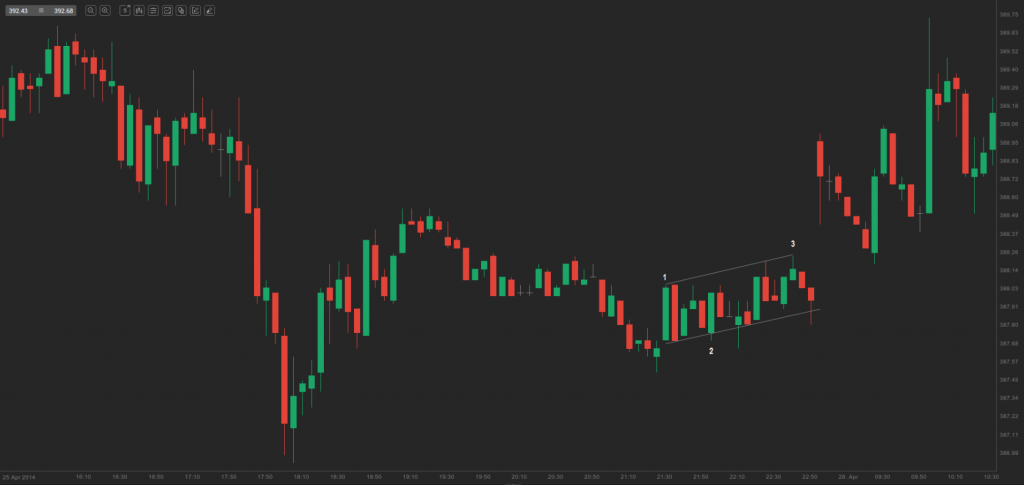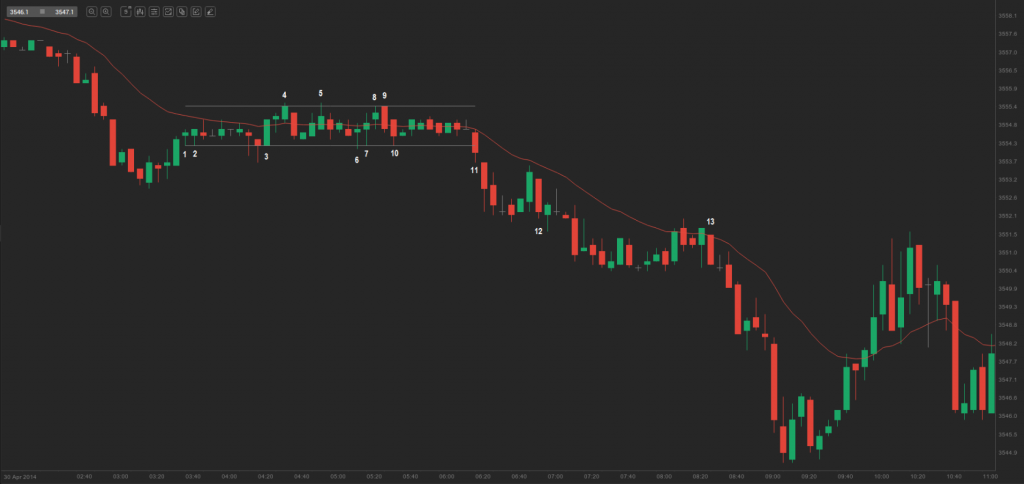Types of trading ranges
This lesson will cover the following
- Tight trading ranges
- Variations of tight ranges
Tight trading ranges
We shall begin with the so called tight trading ranges. These represent any sideways price movement, comprised of at least two and more bars, showing much overlap between each other. Buying and selling activity are balanced, while market players await the eventual breakout from the range and price development after it. Sometimes trading ranges may have a slight slope up or down (as we already said, channels and micro channels can be considered as such), so they should be traded the same way as traditional ranges. As bulls and bears are in balance within the tight trading range, the most appropriate trading decision would be to wait for failed breakouts or pullbacks after breakouts.
On the chart above we can see that, at some point, the market was in a tight trading range with an upward slope. The range followed one sharp and one flatter bear moves, thus, it is reasonable to expect that the range may be protracted and probably lead to two moves to the upside. Actually, the move to bar 3 was the first leg up.
Trading these formations can be quite tricky, so beginners should trade them in rare cases or simply abstain from action and wait for more clarity.
Tight trading ranges, in general, are trend continuation patterns. However, there are cases (a climax occurring, such as a trend channel line overshoot followed by a reversal), in which the price can breach either the upper area or the lower area of the range. This is possible, because the climax has probably induced momentum in the opposite direction. A trader will likely not be aware whether this momentum is to continue and produce a breakout, or the momentum, generated by the original trend, is to continue.
Variations of tight ranges
Other variations of tight trading ranges are horizontal flags and “barb wire” ranges. They usually produce breakouts in the direction of the original trend. At times these formations can encompass over 20 bars with short wicks, at which point, they no longer can be used as a basis for forecasts. In such cases the best decision for a trader is to simply wait for the breakout. Very often breakouts fail within 1-2 bars, so there is a good chance for one to profit, if he/she makes his/her entry on the failure, rather than on the breakout itself.
There are cases, when a failure may turn out to be a pullback following the breakout. Now, a trader would place a stop order in the direction of the breakout, as soon as the bar following the pullback exceeds the extreme price of the pullback bar. If the breakout is to the upside, the trader will likely place a stop order to buy at one tick above the high of the pullback bar. If the pullback bar breaches the opposite side of the range, the trader will likely place a stop order to sell at one tick below the tight trading range.
The move following the breakout is rarely strong, so the market enters a flat trend during the remainder of the trading day (a tight trading range). These formations may contain a number of setups within them (for instance, micro trend line breaches), while trading the latter may turn out to be more profitable than trading breakouts from the range. A trader will likely enter only if the signal bar is a small bar close to the upper or the lower area of the trading range (for example, going short below the low price of a small bar close to the top of the range).
On the 5-minute chart of NDAQ 100 above another tight trading range is visualized. Bar 7 and bar 10 failed to break out from the lower area of the range. The move preceding the range was a bear one and as the majority of bars did not manage to move above and distance from the exponential moving average, it was logical to expect that the breakout from the range would likely be to the downside. Bar 11 was a clear M2S setup (we shall discuss them in one of our next articles) and the third (successful) breakout from the range. Another appropriate short entry would have been 1-2 ticks below the low prices of bars 7 and 10, as well as 1-2 ticks below the daily low. A high-probability short entry would have been on the first pullback after the breakout at bar 12. Bar 13 was another good M2S setup.

